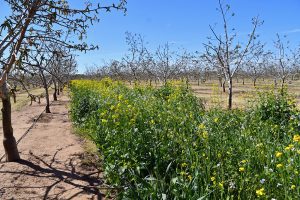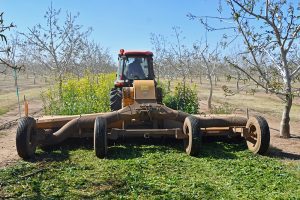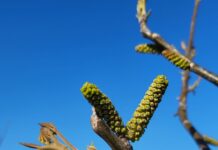
With depressed commodity prices, Linden-area walnut producer James Chinchiolo is like many other growers and wants to reduce input costs, but he plans to do so wisely.
“There’s so much that’s changing with respect to cost that if we don’t adapt, we’re just not going to be here. So, we have to become more efficient,” said Chinchiolo, a fourth-generation farmer. “It’s almost like a race, and perhaps I’m behind a little bit. We’re just trying to catch up with inflation and the cost increases in the last few years. Plus, with declining commodity prices, we’ve got to meet those challenges, and the only way I see that is through efficiency.”
At the same time, he wants to increase returns and reduce risks by selling a larger portion of their harvests directly to consumers and educating them about the value of their crops.
For Chinchiolo, who farms with his father, Tom, the goal isn’t just about dollars and cents. It also includes remaining in business and investing in the long-term health of their operations through practices, such as cover cropping and reducing herbicide and pesticide applications.

“I look at this ground and we’ve been farming it since the ’40s. Before that, it was farmed pretty heavily, and to me, we have to slowly give back to the ground,” he said. “It won’t continue to sustain itself over time without proper care, and I believe cover crop is a big part of that.”
The Chinchiolos farm 220 acres of cherries and walnuts in Lodi and Linden, respectively. In addition, they run a small walnut huller and dryer on their Linden operation that can handle 45 tons per day or up to 60 tons in a 24-hour period.
Investing in the Orchard
For several winters, they have planted cover crops in their walnuts that consist of a five-way blend of vetch, mustard, beans, triticale and radish. In addition to helping build up the soil, he views cover crops as a way to suppress weeds in the orchard middles and reduce their use of costly herbicides. Eventually, Chinchiolo said he hoped to rely on mowing most of the season with possibly just one herbicide application.
Chinchiolo continues to embrace orchard sanitation, something Tom had practiced for years. The goal is to destroy mummies, or nuts left over after harvest, to eliminate overwintering sites for navel orangeworm. Unlike in almonds, where growers winter shake trees to remove mummies, Chinchiolo said the heavier walnuts naturally fall off the trees, especially with a bit of moisture.
He also credited the natural plant growth regulator ethrel for more even ripening and reducing waste during and after harvest. By December, the mummies typically are on the ground.

“What we find is the cleaner we keep the orchard, the better with respect to NOW,” Chinchiolo said. “We’re just trying to eliminate the homes for NOW to get started, and we find it very successful. It’s a practice my dad incorporated many years ago. Back when labor and chemical costs and such were much lower, he was able to make four passes. So, I’m just trying to incorporate what he started doing out here years ago and continue to refine it and make it more efficient.”
How much winter sanitation can be credited for insect control is unknown. But Chinchiolo said it undoubtedly helped, and they applied no insecticides in 2022 for husk fly, NOW, mites or codling moth.
Their walnut trees are planted on 24-by-22-foot spacings. In the past, they would make two passes to blow mummies from each side of the tree row. Then they would have to mow vegetation on each side of the row because of an 11-foot-wide mower. With a new machine that features a 14-foot-wide mower, they now make only one pass to accomplish what formerly took four passes.
From Valley Tool Manufacturing of Hughson, the machine features a Vrisimo Berm Blower that produces 20,000 cubic feet per minute of airflow on each side. Each side can be adjusted to blow debris to the center of adjacent rows. The rear-mounted blower attaches to Vrisimo’s Low Profile Orchard Flail Mower.
In addition, Chinchiolo had Valley Tool weld a receiver hitch on the back of the mower so he can tow an herbicide rig to spray the tree row at the same time if needed. This eliminates another pass. Chinchiolo uses an 80-horsepower tractor to tow behind the rig.
“Every time we’re making a pass in the orchard, we’re trying to accomplish as much as possible to keep our costs down,” he said. “This was a game changer for us.”
Not only do the fewer passes save fuel but they also reduce soil compaction.
Investing in Water Savings, Too
With the help of a State Water Efficiency and Enhancement Program grant, the Chinchiolos installed buried drip irrigation in their orchard, which will allow them to inject fertilizer and other materials through the water and reduce fertilizer ground rig passes. They kept the orchard’s solid-set sprinklers to use to help germinate the cover crop in the fall if needed.
The grant also funded the installation of a variable-frequency drive on their pump, allowing them to throttle back the 100-horsepower pump when they’re irrigating small blocks.
In 2022, Chinchiolo began using a pressure bomb, also known as a pressure chamber, to determine when the trees were beginning to become water stressed and needed irrigating. It also allowed them to delay their first irrigation of the season.
“We had an outstanding response, especially with our younger trees, with pressure bombing,” he said.
Although Chinchiolo admitted that pressure bombing was time-consuming, he said the results were well worth it and he planned to continue using the technology this season.
Vertical Integration
The Chinchiolos own and operate their own huller and dryer, something that Tom started in the 1980s. James said they benefit by having more control over walnut quality.
“Walnuts are a perishable product, and I don’t think a lot of people consider this,” he said. “The sooner the walnut can be dried, the better grades we get. In many instances, we shake, harvest and hull all in the same day.”
Drying kernels down to 7% moisture helps create a more stable product. Not only does it aid in producing walnuts with the coveted light kernel color, but the low moisture also helps inhibit mold growth.
Chinchiolo has been a longtime advocate for agriculture and trying to better connect consumers with the people and processes responsible for the food they eat. As a result, he started the U-Pick and direct-to-consumer cherry operation Lodi Blooms about three years ago. Using social media and short videos, Chinchiolo tries to create year-round interest in the seasonal changes that occur in the orchard. Of course, it culminates when the cherries hit their peak of ripeness.
What he hopes to do is set Lodi Blooms apart from some other direct-marketing operations by creating a premium experience and top-quality fruit. Chinchiolo said he planned to begin doing that this season with their walnuts, although not quite to the scale as the cherries. The walnuts also will be marketed under the Chinchiolo Farming Co. brand.
“As we develop our customer base with our cherries, we’re going to introduce them to our walnuts,” he said. “I think there’s opportunity there, especially between Nov. 1 and Christmas when we can sell truly fresh walnuts, that’s the approach I want to take. I plan to follow what we’ve done with the cherries of producing a premium product and really carve out a niche. We really want to give consumers the opportunity to connect with ag, that’s our mission statement, and I think the best way to do that is put the best product out there.”










